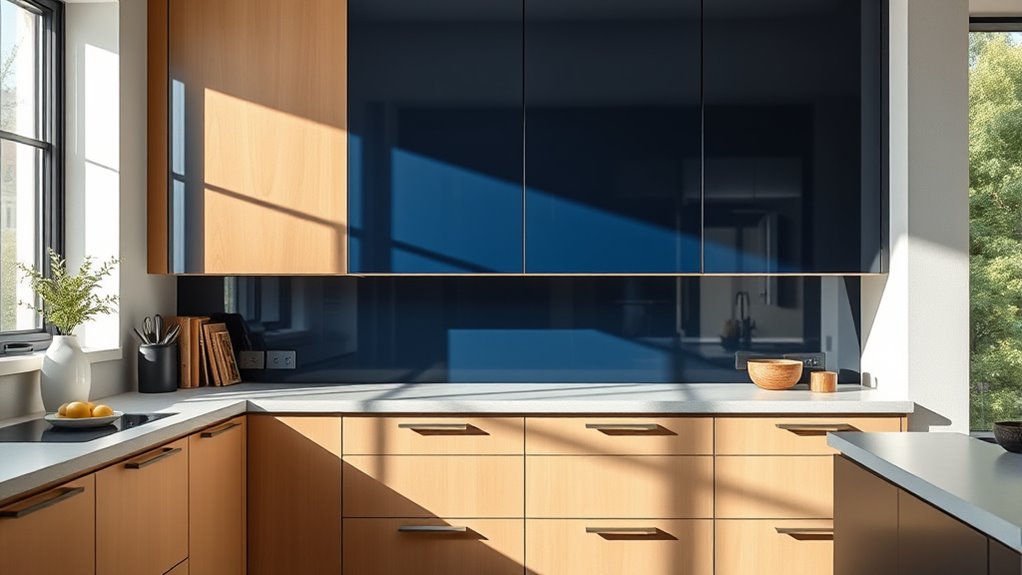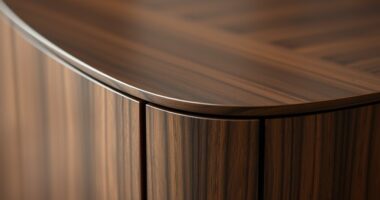To create a balanced two-tone cabinet design, focus on contrasting colors and materials that complement each other, such as light and dark hues like white and navy or beige and espresso. Strategically place bold and neutral shades to achieve harmony without clashing, and incorporate varied textures like matte or glossy finishes to add depth. By thoughtfully combining materials and colors, you’ll craft a kitchen that’s both eye-catching and cohesive—continuing will reveal even more tips for mastering this stylish look.
Key Takeaways
- Use complementary or analogous colors to create visually appealing and balanced two-tone cabinet pairings.
- Strategically place contrasting colors to highlight specific cabinet sections or features for visual interest.
- Incorporate material variations, such as matte and glossy finishes, to add depth and texture to the design.
- Balance bold color choices with neutral tones to maintain harmony and prevent overwhelming the space.
- Ensure overall style consistency, blending contrast and materials to complement the kitchen’s aesthetic.

Are you looking to add visual interest and modern flair to your kitchen? Two-tone cabinet designs are a fantastic way to achieve that, offering a fresh take on traditional cabinetry. When you’re considering this style, the key lies in mastering color pairing and material contrast. These elements allow you to create a balanced look that’s both eye-catching and cohesive.
Start by thinking about how colors interact. You want your cabinet shades to complement each other, so consider pairing light and dark hues for striking contrast. For example, crisp white upper cabinets with deep navy or charcoal lower cabinets can make your space feel open yet grounded. Alternatively, mixing warm tones like soft beige with rich espresso creates a welcoming, cozy vibe. The goal is to find a harmonious balance where the colors work together instead of clashing. It’s helpful to look at color wheels or sample palettes to see which combinations naturally appeal to you.
Material contrast is just as important as color pairing. Think about incorporating different finishes or textures to add depth. For instance, pairing matte cabinets with glossy accents, or wooden doors with painted surfaces, brings a tactile dimension to your kitchen. You might choose natural wood grains on one set of cabinets and sleek painted surfaces on another, which adds visual interest without overwhelming the space. Mixing materials like metal handles or glass panels with wood or painted cabinets can also elevate the design, making it feel more dynamic and layered. Moreover, integrating material contrast thoughtfully can help highlight specific design features and create focal points within your kitchen.
Balancing these elements is vital. Too much contrast can feel jarring, while too little can make your kitchen look dull. Aim for a thoughtful approach: if your upper cabinets are a bold color, keep the lower ones neutral, or vice versa. Incorporate different materials strategically—perhaps a wood veneer on one section paired with painted cabinets on another—to create a sense of flow. Don’t forget to consider your overall style and the existing elements in your kitchen. For example, modern spaces benefit from sleek finishes and sharp color contrasts, while traditional kitchens might favor softer tones and more subtle material differences.
Ultimately, two-tone cabinet designs give you the freedom to express your personality and taste, balancing contrast and harmony to craft a kitchen that feels both fresh and inviting. By carefully selecting your color pairing and emphasizing material contrast, you’ll craft a space that’s visually engaging and perfectly tailored to your lifestyle. It’s all about striking that ideal balance—bold but not overwhelming, varied yet cohesive.
Frequently Asked Questions
How Do I Choose the Right Color Combinations for My Cabinets?
To choose the right color combinations for your cabinets, start by considering color harmony—pick shades that complement each other naturally. Then, balance contrast by mixing light and dark hues to add visual interest without overwhelming the space. Trust your instincts, and test swatches together in your room’s lighting. This way, you create a cohesive look that feels both lively and harmonious, perfectly suited to your style.
What Are the Latest Trends in Two-Tone Cabinet Designs?
Think of your cabinets like a canvas—latest trends embrace bold color blocking and striking material contrasts. You might pair sleek navy with warm wood tones or add matte black accents for depth. Recently, mixing matte and glossy finishes has gained popularity, creating visual interest. These trends let you express your style, balancing contrast and harmony, making your space uniquely yours. Immerse yourself in these ideas to refresh your kitchen with modern flair.
How Can I Make Small Kitchens Look More Spacious With Two-Tone Cabinets?
To make your small kitchen look more spacious, choose light-colored cabinets for the upper parts and darker shades for the lower ones. This color coordination creates a visual expansion by drawing the eye upward and downward. Incorporate sleek, minimalist hardware to enhance openness, and keep countertops clear. These strategies help balance contrast and harmony, making your kitchen feel larger and more inviting.
Are Two-Tone Cabinets Suitable for All Kitchen Styles?
Like a chameleon blending in, two-tone cabinets are versatile enough for many kitchen styles. They work well with modern, traditional, farmhouse, and eclectic designs, thanks to thoughtful color pairing that balances contrast and harmony. However, they might not suit ultra-minimalist or very classic, single-color themes. If you want style versatility and a personalized touch, two-tone cabinets can adapt beautifully, making your kitchen uniquely yours.
What Maintenance Tips Ensure the Longevity of Two-Tone Cabinet Finishes?
To keep your two-tone cabinet finishes looking great, stick to regular cleaning routines using a soft, damp cloth and gentle soap. Avoid harsh chemicals that can damage protective finishes. Always wipe up spills promptly to prevent staining or warping. Applying a protective finish or wax periodically helps maintain the color contrast and shine. These simple steps ensure your cabinets stay beautiful and durable for years to come.
Conclusion
As you explore two-tone cabinet designs, you’ll find that balancing contrast and harmony creates a space that feels both lively and cohesive. Sometimes, a unexpected pairing catches your eye, turning out to be the perfect match for your style. It’s funny how a simple choice can transform your entire room, isn’t it? Trust your instincts and experiment—you might just stumble upon a surprising combination that makes your home uniquely yours.









